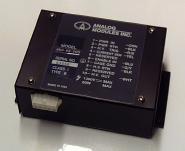
These power supplies can be found on Ebay. It is an obsolete part (and therefore affordable...), but the data-sheet for a model 864 power supply is close enough.
The connector pin out is pretty self-explanatory, and can be found on the case of the power supply anyway. The enable in pin seems to go to an opto-coupler. I assumed it was intended to be driven with TTL, and fed it 5V through a 1K resistor.
I powered it with a 24 VDC power supply, it was allegedly getting 24 VDC at at least 2 amps, which would still be below the data-sheet's rated 60 Watts.
The trigger output is a -520 volt pulse. I connected it to the input of a generic trigger transformer I found on Mouser (1:20 I think). I then externally triggered the lamp with a piece of bare wire against the lamp's envelope, running the length of the arc.
On the first attempt, the trigger transformer arced. alligator clips are not appropriate for high voltage work... I glorped it with hot melt glue. It arced again... I soldered some longer leads to the transformer, and glorped the pins. It arced again, between windings on the coil, but only when the trigger wire was too far from the lamp. Its a test harness, I ignored the problem.
The final observation is that this power supply will reliably simmer up to six inches of arc. Two 4 inch lamps are too long, and two 6 inch lamps are right out (the one in the picture is a 6 inch lamp with an about 18mm bore). This observation is supported by noting the data sheet says its good for 300 volts (1500 open circuit), and that the arc lamps need at least a volt per mm of arc length. (See Heraeus Noblelight's Lamp Book, there is a graph of simmer volts/mm vs current on page 21. (my lamps are 5mm bore, which implies 200 to 300ma of current, see fig 32 on page 20.).)